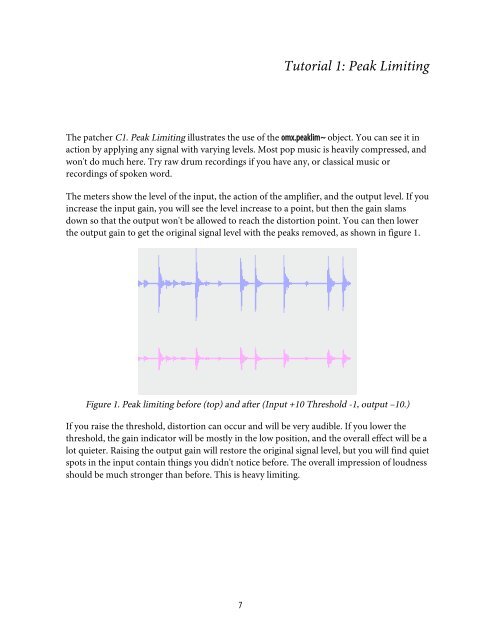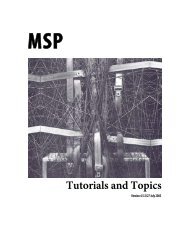MSP; "A Primer on Compression" - Peabody Computer Music
MSP; "A Primer on Compression" - Peabody Computer Music
MSP; "A Primer on Compression" - Peabody Computer Music
You also want an ePaper? Increase the reach of your titles
YUMPU automatically turns print PDFs into web optimized ePapers that Google loves.
Tutorial 1: Peak LimitingThe patcher C1. Peak Limiting illustrates the use of the omx.peaklim~ object. You can see it inacti<strong>on</strong> by applying any signal with varying levels. Most pop music is heavily compressed, andw<strong>on</strong>'t do much here. Try raw drum recordings if you have any, or classical music orrecordings of spoken word.The meters show the level of the input, the acti<strong>on</strong> of the amplifier, and the output level. If youincrease the input gain, you will see the level increase to a point, but then the gain slamsdown so that the output w<strong>on</strong>'t be allowed to reach the distorti<strong>on</strong> point. You can then lowerthe output gain to get the original signal level with the peaks removed, as shown in figure 1.Figure 1. Peak limiting before (top) and after (Input +10 Threshold -1, output –10.)If you raise the threshold, distorti<strong>on</strong> can occur and will be very audible. If you lower thethreshold, the gain indicator will be mostly in the low positi<strong>on</strong>, and the overall effect will be alot quieter. Raising the output gain will restore the original signal level, but you will find quietspots in the input c<strong>on</strong>tain things you didn't notice before. The overall impressi<strong>on</strong> of loudnessshould be much str<strong>on</strong>ger than before. This is heavy limiting.7
















